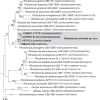Rhodotorula silvicola sp. nov., a new yeast species from plant-associated substrates and mushroom
- PMID: 40643100
- PMCID: PMC12247233
- DOI: 10.1099/ijsem.0.006836
Rhodotorula silvicola sp. nov., a new yeast species from plant-associated substrates and mushroom
Abstract
An orange-coloured yeast strain was recently isolated from rotted leaves in Zunyi City, Guizhou Province, PR China. Phylogenetic analysis revealed that this strain shares identical or similar sequences with no more than two to three nucleotide substitutions in both the 26S rDNA D1/D2 domains and the internal transcribed spacer (ITS) region with three other strains isolated from decayed wood in Indonesia, mushroom in Thailand and a plant of the genus Opuntia in the Bahamas. Therefore, these strains are conspecific. And they are most closely related to Rhodotorula paludigena but exhibit sequence divergences of 2.1-2.6% in the 26S rDNA D1/D2 domains and 2.9-3.2% in the ITS region. Physiologically, strain CGMCC 2.7770 differs from R. paludigena in its ability to assimilate maltose, l-arabinose and citric acid. Both the phylogenetic analysis and phenotypic characteristics indicate that those four strains represent a novel species in the genus Rhodotorula, for which the name Rhodotorula silvicola sp. nov. is proposed (holotype CGMCC 2.7770T).
Keywords: Rhodotorula silvicola sp. nov.; basidiomycetous yeast; phylogeny; taxonomy.
Conflict of interest statement
The authors declare that there are no conflicts of interest.
Figures


Similar articles
-
Rhodotorula tropicalis sp. nov., a novel red yeast of the order Sporidiobolales isolated from Thailand, Indonesia and Japan.Int J Syst Evol Microbiol. 2025 Mar;75(3). doi: 10.1099/ijsem.0.006701. Int J Syst Evol Microbiol. 2025. PMID: 40062422
-
Discovery and identification of a novel yeast species, Hanseniaspora drosophilae sp. nov., from Drosophila in Okinawa, Japan.Int J Syst Evol Microbiol. 2025 Feb;75(2):006661. doi: 10.1099/ijsem.0.006661. Int J Syst Evol Microbiol. 2025. PMID: 39903503 Free PMC article.
-
Yamadazyma oleae f.a. sp. nov. and Yamadazyma molendinolei f.a. sp. nov., two novel ascomycetous yeast species isolated from olive oil mills in Italy, and reassignment of 11 Candida species to the genus Yamadazyma.Int J Syst Evol Microbiol. 2024 Dec;74(12). doi: 10.1099/ijsem.0.006592. Int J Syst Evol Microbiol. 2024. PMID: 39621539
-
Fonsecazyma yulaniae sp. nov., a yeast species isolated from flowers.Int J Syst Evol Microbiol. 2025 Jun;75(6):006830. doi: 10.1099/ijsem.0.006830. Int J Syst Evol Microbiol. 2025. PMID: 40569820 Free PMC article.
-
The Black Book of Psychotropic Dosing and Monitoring.Psychopharmacol Bull. 2024 Jul 8;54(3):8-59. Psychopharmacol Bull. 2024. PMID: 38993656 Free PMC article. Review.
References
-
- Sampaio JP. In: The Yeasts, A Taxonomic Study. 5th edn. Kurtzman CP, Fell JW, Boekhout T, editors. Amsterdam: Elsevier; 1928. Rhodotorula harrison; pp. 1873–1927. - DOI
-
- Sampaio JP. In: The Yeasts, A Taxonomic Study. 5th edn. Kurtzman CP, Fell JW, Boekhout T, editors. Amsterdam: Elsevier; 1967. Rhodosporidium banno; pp. 1523–1539. - DOI
-
- McNeill J, Barrie FR, Buck WR, Demoulin V, Greuter W, et al. International Code of Nomenclature for Algae, Fungi, and Plants (Melbourne Code) Koenigstein, Germany: Regnum Veg; 2012.
MeSH terms
Substances
LinkOut - more resources
Full Text Sources
Research Materials

